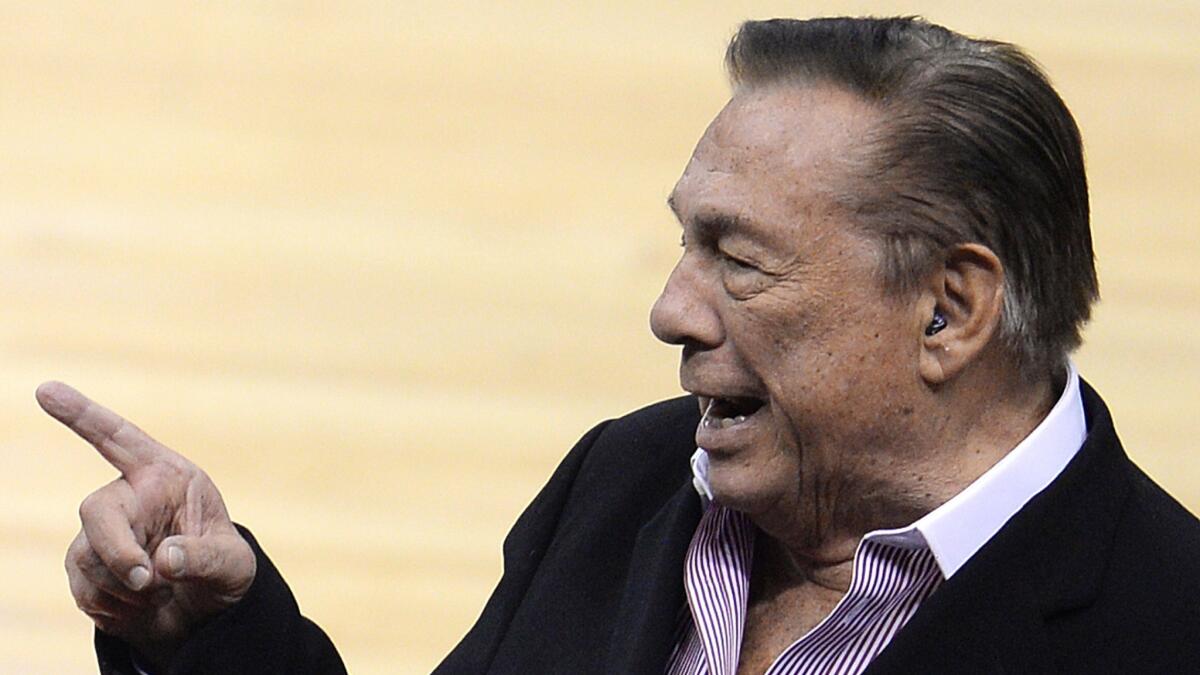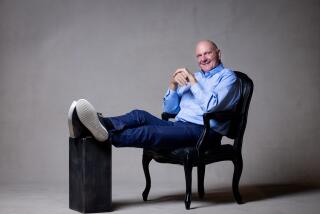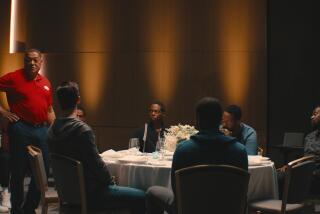What’s next for the Clippers?

- Share via
Adam Silver swung the hammer. Donald Sterling is out. But not quite yet.
He is barred from everything NBA-related, whether it’s getting his car valet-parked underneath Staples Center for a Clippers game or stopping by the team’s practice facility for bottled water.
Yet he still owns the Clippers unless he’s voted out by the 29 other NBA owners, or actually only three-fourths of them, which equates to 22 votes whenever that process begins.
And there’s a new twist uncovered Wednesday by The Times — Sterling and his wife, Shelly, own the Clippers in a trust. Their two adult children, Chris and Joanna, might also be included in it as well.
Confused? Hopefully not much longer.
What happens next?
The NBA advisory/finance committee of 10 owners will hold a conference call Thursday to determine what to do now. It’s a committee that meets occasionally, its members including Lakers governor Jeanie Buss, though this call has been hastily assembled to specifically address the Sterling situation.
All 30 owners aren’t scheduled to meet until a regular mid-July gathering, but a resolution over Sterling is expected well before then, with a vote in a to-be-determined manner.
As has been widely reported, the NBA commissioner could go only so far in banning Sterling for life from all league activities. The owners are the only ones who can actually force the sale of the Clippers.
Will every owner vote for it?
With so much anti-Sterling sentiment in the last few days, voting to not dismiss him could easily brand an owner — and that franchise — in an unflattering way.
An overwhelming majority of owners publicly said they’d support Silver’s desire to make Sterling sell the Clippers, so the symbolic question would be whether the Clippers themselves could vote not to sell.
Sterling isn’t supposed to take part in the day-to-day workings of the team but still owns it, so who casts the Clippers’ vote? Not Sterling, according to a person familiar with the situation.
It’ll either be President Andy Roeser or Coach Doc Rivers, who is also the Clippers’ vice president of basketball operations.
If the Clippers are allowed to vote, 23 of the 30 NBA owners would need to say yes to force the sale of the team. If the Clippers aren’t allowed to take part, 22 yes votes will force a sale.
Will Sterling file a lawsuit to maintain ownership?
That’s the big question.
The NBA office is definitely curious. The league’s attorneys are awaiting his response if he is told to sell.
His wife attended Tuesday’s game surrounded by bodyguards and told Rivers to inform Clippers players that she “loved them,” according to Rivers.
She distanced herself from her husband’s comments with a statement Sunday in which she referred to him as “estranged” but went to dinner with him Monday night and tried to block out paparazzi cameras as they left a steakhouse.
Sterling and his wife might not be ready to vacate ownership of the franchise they’ve held for 33 years.
Who will end up with the team if Sterling is forced to sell?
Seemingly everybody’s lining up to buy the Clippers.
The triumvirate of Oprah Winfrey, David Geffen and Larry Ellison. Magic Johnson/Guggenheim. Champion boxers Floyd Mayweather Jr. and Oscar De La Hoya. “Malcolm in the Middle” star Frankie Muniz, a Clippers fan, even tweeted that he was interested.
A former Lakers player emailed the NBA on Wednesday with an offer to purchase the Clippers.
For $20.
He was joking.
The early leader would sensibly be Johnson. He has long wanted an NBA franchise and wasn’t merely satisfied owning about 4% of the Lakers, selling his stake in 2010. With backing from Guggenheim Partners, the same group he teamed with to purchase the Dodgers for $2.15 billion, Johnson would seem a natural fit.
Sorry, Lakers fans.
How have the Clippers handled this thing?
Cautiously, if not defensively, and then not so cautiously.
The first statement the Clippers released Saturday swiped at V. Stiviano’s character in only the third sentence, portraying Sterling’s female friend as someone who wanted to “get even” with him. The Clippers also initially cast doubt on the authenticity of the recording, which Sterling later admitted was him, according to Silver.
Fast-forward to Tuesday.
The Clippers’ statement had a completely different tenor, include a phrase that they “wholeheartedly support and embrace” Silver’s decision before adding that “now the healing process begins.”
The turnaround was complete later in the day when the Staples Center scoreboard pointedly showed fans numerous times wearing anti-Sterling T-shirts or waving anti-racism signs in the crowd for the Clippers’ playoff game.
Twitter: @Mike_Bresnahan
More to Read
Go beyond the scoreboard
Get the latest on L.A.'s teams in the daily Sports Report newsletter.
You may occasionally receive promotional content from the Los Angeles Times.











